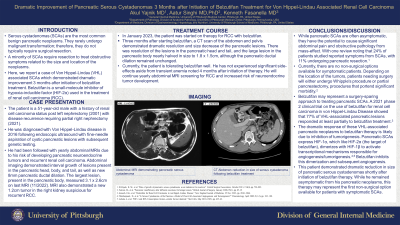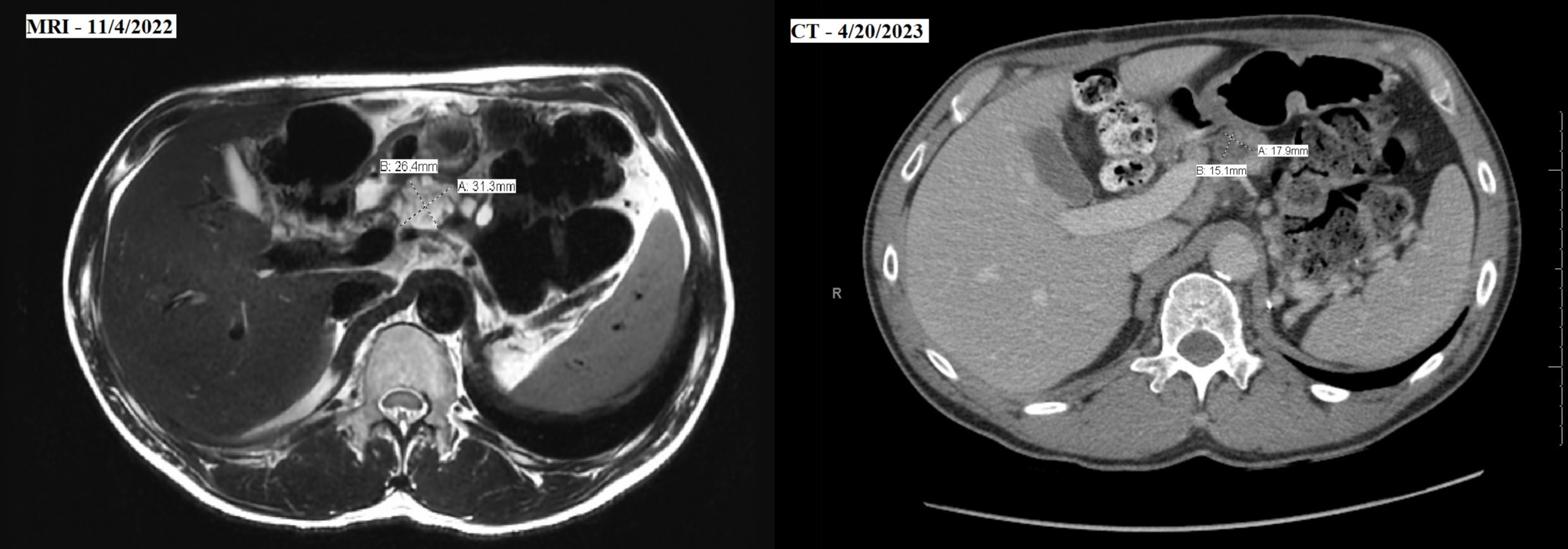Monday Poster Session
Category: Biliary/Pancreas
P1478 - Dramatic Improvement of Pancreatic Serous Cystadenomas 3 Months After Initiation of Belzutifan Treatment for Von Hippel-Lindau Associated Renal Cell Carcinoma
Monday, October 23, 2023
10:30 AM - 4:15 PM PT
Location: Exhibit Hall

Has Audio

Akul Yajnik, MD
University of Pittsburgh Medical Center
Pittsburgh, PA
Presenting Author(s)
Akul Yajnik, MD, Kenneth Fasanella, MD, Aatur Singhi, MD, PhD
University of Pittsburgh Medical Center, Pittsburgh, PA
Introduction: Serous cystadenomas (SCAs) are the most common benign pancreatic neoplasms. They rarely undergo malignant transformation; therefore, they do not typically require surgical resection. A minority of SCAs require resection to treat obstructive symptoms related to the size and location of the neoplasms. Here, we report a case of Von Hippel-Lindau (VHL) associated SCAs which demonstrated dramatic improvement 3 months after initiation of belzutifan treatment.
Case Description/Methods: The patient is a 51-year-old male with a history of renal cell carcinoma (RCC) status post left nephrectomy (2001) with disease recurrence requiring partial right nephrectomy (2021). He was diagnosed with Von Hippel-Lindau disease in 2016 following endoscopic ultrasound with fine-needle aspiration of cystic pancreatic lesions with subsequent genetic testing. He has been followed with yearly abdominal MRIs due to risk of pancreatic neuroendocrine tumors and renal cell carcinoma, which demonstrated interval growth of lesions present in the pancreatic head, body, and tail, as well as new 8mm pancreatic ductal dilation. The largest lesion, present in the pancreatic body, measured 3.1 x 2.6cm on last MRI (11/2022). MRI also demonstrated a new 1.2cm tumor in the right kidney suspicious for recurrent RCC. Two months later, he started therapy for RCC with belzutifan, a small-molecule hypoxia-inducible factor (HIF-2α) inhibitor. Three months after starting belzutifan, a CT scan of the abdomen and pelvis demonstrated dramatic resolution and size decrease of the pancreatic lesions. There was resolution of the lesions in the pancreatic head and tail, and the large lesion in the pancreatic body nearly halved in size to 1.8 x 1.5cm, although the pancreatic ductal dilation remained unchanged.
Discussion: While pancreatic SCAs are often asymptomatic, they have the potential to cause significant abdominal pain and obstructive pathology from mass-effect. Currently, there are no non-surgical options available for symptomatic patients. Belzutifan may represent a surgery-sparing approach to treating pancreatic SCAs. A 2021 phase 2 clinical trial showed that 77% of VHL-associated pancreatic lesions responded at least partially to belzutifan treatment1.
1Jonasch, Eric, et al. “Belzutifan for Renal Cell Carcinoma in von Hippel–Lindau Disease.” New England Journal of Medicine, 25 Nov. 2021, pp. 2036–2046.

Disclosures:
Akul Yajnik, MD, Kenneth Fasanella, MD, Aatur Singhi, MD, PhD. P1478 - Dramatic Improvement of Pancreatic Serous Cystadenomas 3 Months After Initiation of Belzutifan Treatment for Von Hippel-Lindau Associated Renal Cell Carcinoma, ACG 2023 Annual Scientific Meeting Abstracts. Vancouver, BC, Canada: American College of Gastroenterology.
University of Pittsburgh Medical Center, Pittsburgh, PA
Introduction: Serous cystadenomas (SCAs) are the most common benign pancreatic neoplasms. They rarely undergo malignant transformation; therefore, they do not typically require surgical resection. A minority of SCAs require resection to treat obstructive symptoms related to the size and location of the neoplasms. Here, we report a case of Von Hippel-Lindau (VHL) associated SCAs which demonstrated dramatic improvement 3 months after initiation of belzutifan treatment.
Case Description/Methods: The patient is a 51-year-old male with a history of renal cell carcinoma (RCC) status post left nephrectomy (2001) with disease recurrence requiring partial right nephrectomy (2021). He was diagnosed with Von Hippel-Lindau disease in 2016 following endoscopic ultrasound with fine-needle aspiration of cystic pancreatic lesions with subsequent genetic testing. He has been followed with yearly abdominal MRIs due to risk of pancreatic neuroendocrine tumors and renal cell carcinoma, which demonstrated interval growth of lesions present in the pancreatic head, body, and tail, as well as new 8mm pancreatic ductal dilation. The largest lesion, present in the pancreatic body, measured 3.1 x 2.6cm on last MRI (11/2022). MRI also demonstrated a new 1.2cm tumor in the right kidney suspicious for recurrent RCC. Two months later, he started therapy for RCC with belzutifan, a small-molecule hypoxia-inducible factor (HIF-2α) inhibitor. Three months after starting belzutifan, a CT scan of the abdomen and pelvis demonstrated dramatic resolution and size decrease of the pancreatic lesions. There was resolution of the lesions in the pancreatic head and tail, and the large lesion in the pancreatic body nearly halved in size to 1.8 x 1.5cm, although the pancreatic ductal dilation remained unchanged.
Discussion: While pancreatic SCAs are often asymptomatic, they have the potential to cause significant abdominal pain and obstructive pathology from mass-effect. Currently, there are no non-surgical options available for symptomatic patients. Belzutifan may represent a surgery-sparing approach to treating pancreatic SCAs. A 2021 phase 2 clinical trial showed that 77% of VHL-associated pancreatic lesions responded at least partially to belzutifan treatment1.
1Jonasch, Eric, et al. “Belzutifan for Renal Cell Carcinoma in von Hippel–Lindau Disease.” New England Journal of Medicine, 25 Nov. 2021, pp. 2036–2046.

Figure: CT imaging obtained 3 months after initiation of belzutifan therapy demonstrated marked reduction in the size and number of pancreatic serous cystadenomas when compared to previous MRI studies.
Disclosures:
Akul Yajnik indicated no relevant financial relationships.
Kenneth Fasanella indicated no relevant financial relationships.
Aatur Singhi indicated no relevant financial relationships.
Akul Yajnik, MD, Kenneth Fasanella, MD, Aatur Singhi, MD, PhD. P1478 - Dramatic Improvement of Pancreatic Serous Cystadenomas 3 Months After Initiation of Belzutifan Treatment for Von Hippel-Lindau Associated Renal Cell Carcinoma, ACG 2023 Annual Scientific Meeting Abstracts. Vancouver, BC, Canada: American College of Gastroenterology.
